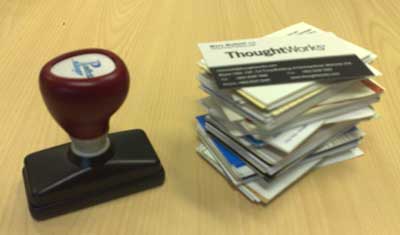Goodbye Luke
The cruel hand of death has plucked a good friend, mentor and inspiration from us. I wouldn’t be where I am today without Luke Barrett; he shone a light for me to follow. For someone with so much energy, so much more to give the world, with a young family and a life ahead of him, his death is truly tragic.
I first met Luke at Accenture, or Andersen Consulting as it was at the time. He was doing some interactive stuff and was looking to do some usability testing on Digital TV. Our paths crossed and we started usability testing our clients products. This was in 1999 and ‘design evaluation’ as we called it was quite an innovation at the time.
We worked together on Barclays iBank, rigorously validating our designs with customers, helping the bank transform their first generation, clunky IT-centric on-line banking application into something friendly and usable. Ahead of its time, Luke championed the Rapid Proposition Development offering – you’d call it Lean Startup today. His creativity, work rate and energy were both inspiring and infectious. Working weekends with him, building interactive prototypes to validate assumptions wasn’t work; it was a fun thing to do. We worked with an overseas bank who were looking to enter the UK market. Undoubtedly we saved them millions of pounds by demonstrating that their idea, when presented to potential customers was worthless.
Luke was a rare breed, truly creative, with an eye for design (visual and interactive), and a keen technologist as well. On one project we worked on together, a contractor was brought in to build a Flash investment calculator. The contractor was unable to deliver on Luke’s vision, so he taught himself Flash and over a weekend built something awesome.
Luke left Accenture to pursue other opportunities, but still came back from time to time to run training sessions on Photoshop and Illustrator. Our paths crossed again shortly after he joined ThoughtWorks. A consultancy full of uber-geek developers who at the time had little idea of the importance of user centred design. Luke persuaded me to join him on a mission to fuse agile with user experience. Taking a pay cut to join Luke again was a no-brainer. He’d just completed a two week gig at a Building Society where not a line of code was written (but the client had a vision of what needed to be built). This had demonstrated to the ThoughtWorks team that their may be legs in this UCD stuff. And from that we started doing “Quickstarts,” which later became project inceptions -understanding the what before the how. Curious, he was always looking to learn and had an idea or balanced opinion on most things.
Always a quiet man, not one to seek fanfare or acclaim, I’m certain that in a small way Luke has helped influence the way we build software. Not long ago was I talking to Geoff Patton and he was telling me how Luke influenced much of his thinking. There are many products that people use and love that are just that much better from his hand.
After seven great years at ThoughtWorks I decided to leave. We kept in touch, Luke helping shape ThoughtWorks out of its London base to a European presence. We met up every few months, he’d always ask when I was going to come back to ThoughtWorks. It was this time last year that he mentioned Auto Trader to me and once again he had a hand in my fate.
Whatever he did, wherever he went, Luke applied his passion and drive. Whether it be on the dance floor, mentoring team members, managing prickly client relationships or dealing with prima-donna developers, Luke gave 100%.
Luke. You are gone but never forgotten.

